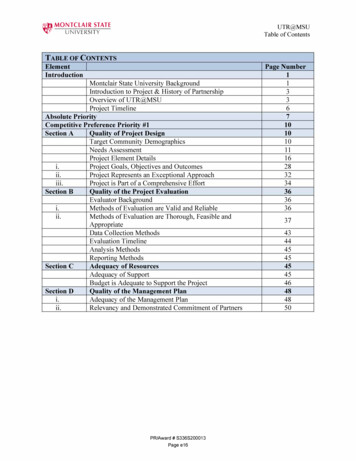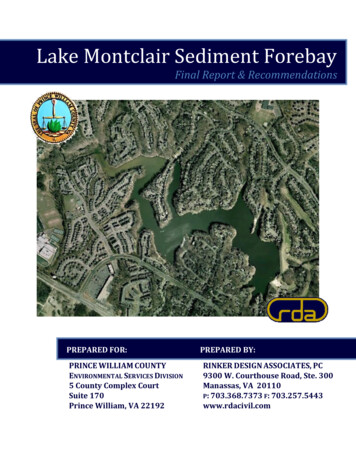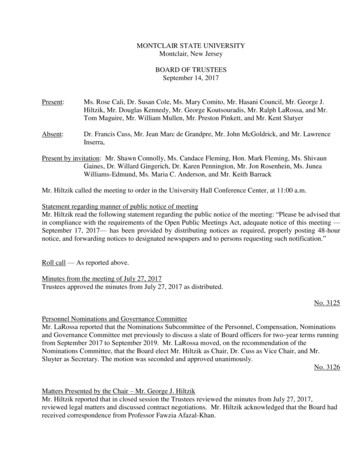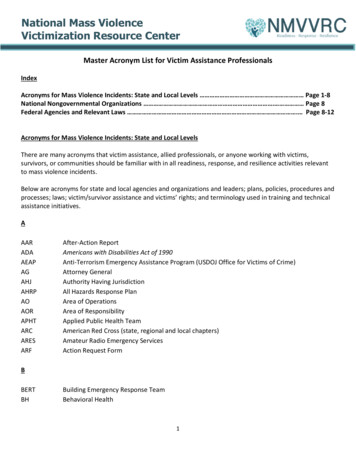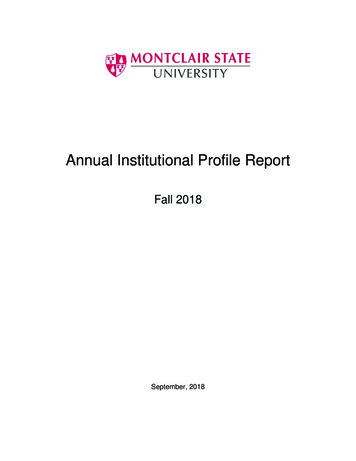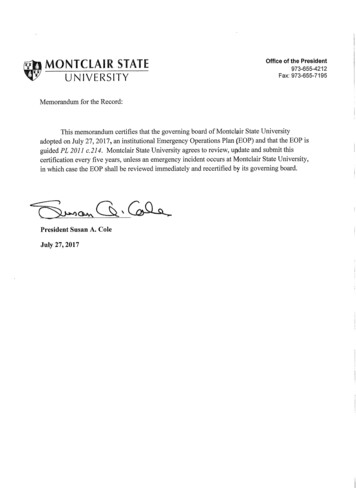
Transcription
MONTCLAIR STATE UNIVERSITY EMERGENCY OPERATIONS PLANEMERGENCYOPERATIONSPLANJuly 2017MONTCLAIR STATE UNIVERSITY POLICE DEPARTMENT, OFFICE OF EMERGENCY MANAGEMENT1
MONTCLAIR STATE UNIVERSITY EMERGENCY OPERATIONS PLANMONTCLAIR STATE UNIVERSITY EMERGENCY OPERATIONS PLANI.A.B.C.D.E.INTRODUCTIVE MATERIALS:Table of Contents . . 02Approval and Implementation . 05Record of Changes . .06Distribution List . 07Letter of Promulgation . 08II.III.IV.V.VI.VII.Authority . 09Plan Development and Maintenance . . . .10Introduction . 11Purpose.12Situation . .12Scope .14VIII.Levels of Emergencies .15IX.Operations and Control.16X.Continuity of Operations.26XI.Reporting procedures to other levels of Government .26XII.Administration and Logistics .28XIII.Emergency Management Training and Exercises.26XIV.Campus Emergency Equipment . 27XV.Responsibilities .32MONTCLAIR STATE UNIVERSITY POLICE DEPARTMENT, OFFICE OF EMERGENCY MANAGEMENT2
MONTCLAIR STATE UNIVERSITY EMERGENCY OPERATIONS PLANANNEXES:A. ALERT WARNING AND COMMUNICATION ANNEXB. EARLY NOTIFICATION SYSTEM ANNEXC. EVACUATION ANNEXD. EMERGENCY OPERATIONS CENTER ANNEXE. ACTIVE SHOOTER/ ACTIVE VIOLENCE ANNEXF. EARTHQUAKE RESPONSE ANNEXG. FIRE RESPONSE ANNEXH. HAZARDOUS MATERIALS INCIDENT ANNEXI. GAS PIPELINE COMPROMISE ANNEXJ. TRAIN DERAILMENT RESPONSE ANNEXK. BOMB THREAT/IMPROVISED EXPLOSIVE DEVICE RESPONSE ANNEXL. PUBLIC HEALTH ANNEXM. BUSINESS CONTINUITY ANNEXN. ACADEMIC CONTINUITY ANNEXO. PUBLIC WORKS AND FACILITIES ANNEXP. FIRE AND RESCUE ANNEXQ. SEVERE WEATHER AND FLOODING ANNEXR. POWER FAILURE ANNEXS. EMERGENCY MEDICAL ANNEXT. EMERGENCY SHELTER ANNEXU. LAW ENFORCEMENT ANNEXMONTCLAIR STATE UNIVERSITY POLICE DEPARTMENT, OFFICE OF EMERGENCY MANAGEMENT3
MONTCLAIR STATE UNIVERSITY EMERGENCY OPERATIONS PLANINTENTIONALLY LEFT BLANKMONTCLAIR STATE UNIVERSITY POLICE DEPARTMENT, OFFICE OF EMERGENCY MANAGEMENT4
MONTCLAIR STATE UNIVERSITY EMERGENCY OPERATIONS PLANC.RECORD OF CHANGESChange numberDate ofChangeDecember 1,20141. Initial Plan2. Update3. BOT ReviewNovember1,2015July 27, 2017Entered byDate EnteredDirectorMatthew D.GallupPaul M. Cell12-01-14Paul M. Cell07-24-1705-01-16MONTCLAIR STATE UNIVERSITY POLICE DEPARTMENT, OFFICE OF EMERGENCY MANAGEMENT6
MONTCLAIR STATE UNIVERSITY EMERGENCY OPERATIONS PLAND.DISTRIBUTION LIST1. University President2. Chief of Police3. Director of Emergency Planning4. Emergency Management Team Members5. Emergency Operations Center6. Each individual responsible for a functional Annex7. Passaic County Office of Emergency Management8. Essex County Office of Emergency Management9. New Jersey State Police – Office of Emergency Management10. Montclair State University Police Communications Desk11. New Jersey Governor’s OfficeMONTCLAIR STATE UNIVERSITY POLICE DEPARTMENT, OFFICE OF EMERGENCY MANAGEMENT7
MONTCLAIR STATE UNIVERSITY EMERGENCY OPERATIONS PLANLETTER OF PROMULGATIONThis Montclair State University Emergency Operations Plan (EOP) describes the duties andresponsibilities of designated individuals, departments, agencies, and volunteer organizations inthe event of a disaster. The plan directs individuals and organizations to provide guidance,relief, and assistance as necessary to mitigate, prepare for, respond to, and recover from theeffects of a disaster that might or has occurred at Montclair State University. The plan isdesigned to explicitly protect the welfare and safety of faculty, staff, students and visitors to theUniversity. It provides the opportunity for the University community to be better prepared forand to quickly recover from an emergency, thereby saving lives, resources and Universityassets. In accordance with Homeland Security Presidential Directive (HSPD) 5, all Universityagencies or departments who have responsibilities delineated in this EOP will use the NationalIncident Management System (NIMS), including the Incident Command System. NIMS insuresproper coordination between local, state, and federal agencies in responding to an emergency.Pursuant to the authority of the Board of Trustees of Montclair State University and myauthority as the President of the University, this Emergency Operations Plan, its attachments,appendices, and annexes are adopted as policy. All administrators, department chairs,directors, or functional managers delegated responsibilities pursuant to this plan, are herebydirected to take the necessary actions to familiarize themselves with this EOP and to beprepared to carry out their responsibilities. This plan replaces all previous emergencyoperations planning documents, and anyone in possession of an old plan should return it to theDirector of Emergency Planning for destruction.The University Chief of Police and the Director of Emergency Planning are designated as theresponsible officials to coordinate, implement, and supervise emergency operations on behalfof the President, and other administrative officers of the University. The Director of EmergencyPlanning is empowered to coordinate with other local, state, and federal emergency operationsagencies in the event of emergencies that may require implementation of this plan.Dr. Susan A. Cole, PresidentMontclair State University07/27/2017MONTCLAIR STATE UNIVERSITY POLICE DEPARTMENT, OFFICE OF EMERGENCY MANAGEMENT8
MONTCLAIR STATE UNIVERSITY EMERGENCY OPERATIONS PLANII. AUTHORITY:1. Federal:1. Robert T. Stafford Disaster Relief & Emergency Assistance Act, (asamended), 42 USC§ 51212. Emergency Planning and Community Right-to-Know Act, 42 USC Chapter1163. Emergency Management and Assistance, 44 CFR4. Hazardous Waste Operations & Emergency Response, 29 CFR 1910.1205. Homeland Security Act 20026. Homeland Security Presidential Directive, HSPD-5, Management ofDomestic Incidents7. Homeland Security Presidential Directive, HSPD-3, Homeland SecurityAdvisory System8. National Incident Management System9. National Response Framework10. National Strategy for Homeland Security, July 20022. State of New Jersey1. N.J.S.A 18A2. Directives issued by the New Jersey State Office of EmergencyManagement Directives 61, 74, 79, 84, 100, 101, 102, 103 and 104.3. University RegulationsMONTCLAIR STATE UNIVERSITY POLICE DEPARTMENT, OFFICE OF EMERGENCY MANAGEMENT9
MONTCLAIR STATE UNIVERSITY EMERGENCY OPERATIONS PLANIII. PLAN DEVELOPMENT AND MAINTENANCE:A. Annual reviewThe Emergency Operations Plan will be reviewed annually and will beupdated and revised as appropriate.B. Maintenance of PlanInterim revisions will be made in the following circumstances:1. A change in university site or facility configuration that materially altersthe information contained in the plan or materially affects implementationof the Emergency Operations Plan2. A material change in response resources3. An incident occurs that requires a review4. Internal assessments, third party reviews, or experience in drills or actualresponses identify significant changes that should be made in the plan5. New laws, regulations, or internal policies are implemented that affectthe contents or the implementation of the planMONTCLAIR STATE UNIVERSITY POLICE DEPARTMENT, OFFICE OF EMERGENCY MANAGEMENT10
MONTCLAIR STATE UNIVERSITY EMERGENCY OPERATIONS PLANIV. INTRODUCTIONThe Montclair State University Emergency Operations Plan identifies natural andman-made emergencies that may impact the campus community. It details the responseprocedures that campus officials should follow in case of an emergency. All departmentswithin the Montclair State University community should become familiar with this plan.As appropriate, they should formulate their own specific action plans and emergencyoperations checklists to complement this plan, and submit a copy to the Director ofEmergency Planning for review and approval.This Emergency Operations Plan is intended for the main campus as well as anyand all locations that are leased, owned or managed by Montclair State University.University emergency operations will be conducted within the framework ofUniversity policies and procedures. Any deviation from the Emergency Operations Planwill be with the approval of the University administrators directing and/or coordinatingemergency operations. An Emergency Executive Group co-chaired by the Chief of theMontclair State University Police and the Director of Emergency Planning, shall meetevery two years to review the University’s Emergency Operations Plan for necessaryupdates and revisions. During alternate years, all requests for procedural changes,suggestions, or recommendations will be submitted in writing to the Director ofEmergency Planning for evaluation. All changes recommended by the Director ofEmergency Planning will be submitted for approval in writing to the President and, ifapproved, shall be included in the plan.Montclair State University has over 21,000 students with more than 5,000students residing on campus. Montclair State University’s main campus is located inEssex and Passaic Counties on 250 acres within Little Falls and Montclair Townships aswell as the City of Clifton. Within the campus boundaries, Floyd Hall Enterprisesmanages two facilities that include the Yogi Berra Stadium hosting a minor leaguebaseball team and an ice arena that hosts numerous ice related sporting events.Montclair State University also has a School of Conservation located in Branchville, NewJersey located in Sussex County. This Emergency Operations Plan is intended for themain campus as well as any and all locations that are leased, owned or managed byMontclair State University.MONTCLAIR STATE UNIVERSITY POLICE DEPARTMENT, OFFICE OF EMERGENCY MANAGEMENT11
MONTCLAIR STATE UNIVERSITY EMERGENCY OPERATIONS PLANV. PURPOSE:A. Various federal and state laws require the University to have an emergencyplan. The plan is intended to protect lives and property, and to maintain anenvironment suitable for the orderly conduct of education. Since an emergencymay strike without warning, this plan is designed to be flexible and assist theUniversity community in answering three basic questions:“What should I do?”This plan describes the overall operational concepts relative to readiness foremergency response and recovery.“How should I do it?”This plan describes the Incident Command System (ICS) and the National IncidentManagement System/ Standardized Emergency Management System (NIMS),which is the management system used to cope with an emergency.“What should I know?”This plan outlines the general actions and information necessary to managingemergency response situations.This plan is an all hazard approach to emergency management and covers naturaldisasters, technological disasters, and national security crises.VI.SITUATION:A. General Description1. Montclair State University is one square mile in size and is an academiccommunity with residential housing, academic/ classroom facilities,administrative and service facilities, recreational and athletic facilities,research facilities, agricultural areas and undeveloped preserves. Thecampus is surrounded by developed residential, commercial, and lightindustrial areas.MONTCLAIR STATE UNIVERSITY POLICE DEPARTMENT, OFFICE OF EMERGENCY MANAGEMENT12
MONTCLAIR STATE UNIVERSITY EMERGENCY OPERATIONS PLAN2. The University is located in northeastern Essex County and in southernPassaic County. University property extends into the followingmunicipalities: the Township of Montclair, the Township of Little Falls, andthe City of Clifton.3. During the academic year (September through May) the University has aresidential population of more than 5,000 people and a workdaypopulation of 21,000. During the months of May through August there is areduced resident population of approximately 2,000 and a workdaypopulation of approximately 6,000 (faculty, students, and staff).4. Primary land transportation routes that pass through or are adjacent tothe Montclair State University campus include the following:a. Route 46b. Route 3c. Valley Roadd. Normal Avenuee. Clove Roadf. Yogi Berra Driveg. Long Hill Roadh. Webster Roadi. College Avenuej. New Jersey Transit CSX Rail lineB. Identified HazardsHazards which may affect Montclair State University include but arenot limited to:1. Severe Weather2. Localized flooding3. Power failures4. Hazardous Materials incidents5. Civil disturbances/disorder6. Major fires/explosionsMONTCLAIR STATE UNIVERSITY POLICE DEPARTMENT, OFFICE OF EMERGENCY MANAGEMENT13
MONTCLAIR STATE UNIVERSITY EMERGENCY OPERATIONS PLAN7. Public health incidents (Pandemics)8. Improvised Explosive Devices/ Bomb Threats9. Transportation Accidents10. Active Shooter/ Terrorist AttacksC.ASSUMPTIONS:1. The Emergency Operations Plan is based on a realistic approach tothe problems likely to be encountered by the University during amajor emergency. The plan assumes that:2. An emergency can occur at any time of the day or night,weekends or holidays, with little or no warning.3. Since events in an emergency are not predictable, this EOP canserve only as a guide and may require modification to meet therequirements of the emergency or disaster.4. This EOP assumes that circumstances may prevent city, county orfederal emergency assistance from being available for 72 hours ormore.VII.SCOPE:A.B.C.The Emergency Operations Plan applies to all Montclair StateUniversity personnel (faculty, staff, students, and visitors) and allbuildings, grounds and satellite properties owned, leased, andoperated by the University.For example, this plan applies to the satellite campus in Branchvilleand properties in Clifton and Bloomfield.PLAN PRIORITIES:1. To protect persons and address the needs of survivorsMONTCLAIR STATE UNIVERSITY POLICE DEPARTMENT, OFFICE OF EMERGENCY MANAGEMENT14
MONTCLAIR STATE UNIVERSITY EMERGENCY OPERATIONS PLAN2. To protect property3. To provide public information4. To restore essential services and instructionVIII. LEVELS OF EMERGENCIES:A. The Montclair State University emergency response will be based on theseverity of the event and the availability of local resources. Generally,response to a major emergency will progress from local to regional tostate to federal involvement.1. Level 1 - A Level 1 emergency is an event that occurs on the maincampus or satellite properties and is managed from the scene orat University Police Headquarters. The event can be handled withexisting University resources or limited outside agency assistance.A Level 1 emergency is usually a single or one-dimensional eventof limited duration with little or no impact on Universityoperations. The Emergency Operations Center (EOC) is notactivated. All responders coordinate via established telephones,radio systems and dispatch centers. A campus state of emergencyis generally not proclaimed.2. Level 2 - A Level 2 emergency is an event involving some or all ofthe University that may require resources, assistance, and / orcoordination with city, county, or state agencies. Level 2emergencies are most likely multi-hazard situations. TheEmergency Operations Center may or may not be activated. Acampus state of emergency might be proclaimed.3. Level 3 - A Level 3 emergency is a situation involving the entirecampus and possibly the surrounding community. Immediateresolution of the emergency is beyond the resource capabilities ofthe University and requires resources, assistance, andcoordination with local, county and state agencies. Level 3MONTCLAIR STATE UNIVERSITY POLICE DEPARTMENT, OFFICE OF EMERGENCY MANAGEMENT15
MONTCLAIR STATE UNIVERSITY EMERGENCY OPERATIONS PLANemergencies are generally multi-hazard, and outside help may notbe immediately available. The Emergency Operations Center isactivated. A campus state of emergency is proclaimed.4. Level 4 - A Level 4 emergency is a catastrophic situation involvingthe entire campus and surrounding community. Immediateresolution of the disaster is beyond the resource capabilities ofthe University and local, county and state resources and willrequire federal resources. Level 4 emergencies are multi-hazard,and outside help may not be immediately available. TheEmergency Operations Center is activated. A campus state ofemergency is proclaimed.IX. OPERATIONS AND CONTROLA. Operational Concepts1. Emergency Management Chain of Commanda. The University President is ultimately responsible for theUniversity’s overall response to emergencies. The President hasdesignated the Chief of Police and the Director of EmergencyPlanning as the responsible officials to coordinate, implement, andsupervise emergency operations. The Chief of Police will serve asthe primary emergency manager and will assume charge of allemergency situations. The Director of Emergency Planning willserve as the number two University officer-in-charge and will serveas emergency manager in the absence of the Chief of Police.b. Normal day to day operations including most limited emergenciesoccurring on the grounds of Montclair State University shall be theresponsibility of the respective vice presidents.MONTCLAIR STATE UNIVERSITY POLICE DEPARTMENT, OFFICE OF EMERGENCY MANAGEMENT16
MONTCLAIR STATE UNIVERSITY EMERGENCY OPERATIONS PLANc. Should a public safety emergency arise that requires a significantmulti-department response, the Director of Emergency Planningwill activate the Emergency Management Team (EMT). This team iscomprised of administrators and department heads whoseorganizations have emergency response functions or resources. TheDirector of Emergency Planning will coordinate the response effortsof the various team members.d. During emergencies requiring the activation of the EMT,administrative department heads will remain in charge of theirrespective departments.2. Actions Implemented During Periods of Increased Risk1. During periods of heightened risk, initial emergency direction andcontrol will emanate from the University Police Department. If itbecomes necessary to activate the EMT, an Emergency OperationsCenter (EOC) will be established at the Abbott and Costello buildingon the second floor. If the EOC needs to be relocated then UniversityPolice Headquarters or the Little Falls Police Department EOC can beutilized.2. During periods of heightened risk, the Emergency ManagementTeam or designees will perform the following actions:1. Alert university officials of potential hazards2. Ascertain recall duty status and availability of personnel3. Recall personnel to report to their respective Universitydepartments for standby4. Brief department employees and/or volunteers on thepotential impending hazard5. Check university emergency equipment6. Deploy department personnel into affected areas7. Determine need for 24 hour staffingMONTCLAIR STATE UNIVERSITY POLICE DEPARTMENT, OFFICE OF EMERGENCY MANAGEMENT17
MONTCLAIR STATE UNIVERSITY EMERGENCY OPERATIONS PLAN3. Incident Command SystemThe University Police Department and Emergency Services and otherdepartments with essential emergency response functions follow theNational Incident Command System (NIMS)/Incident Command (ICS)format for managing emergencies and are expected to maintaintraining and knowledge in its use.4. Reduction of Routine ServicesDuring emergency situations, there may be a reduction and/orelimination of normal public services provided by Universitydepartments (e.g., instruction, support services, transportation andspecial events) for safety reasons or to allow personnel and resourcesto be redirected to emergency operations.5. University State of Emergencya. In the event of a severe emergency condition the UniversityPresident may declare a University State of Emergency, generallyafter consulting with the Chief of Police (or Director of EmergencyPlanning in the absence of the Chief of Police), IncidentCommander, and the President’s Executive Council.b. When a University State of Emergency is declared, all knownparameters relating to the emergency shall be included in theemergency declaration:1.2.3.4.5.6.Specific instructions to the University CommunityReduction of public servicesRestrictions of traffic flowEvacuationsDiversion of University resourcesRequests for municipal, county, or state assistanceMONTCLAIR STATE UNIVERSITY POLICE DEPARTMENT, OFFICE OF EMERGENCY MANAGEMENT18
MONTCLAIR STATE UNIVERSITY EMERGENCY OPERATIONS PLANc. Upon declaration of a University State of Emergency, Universityresources will be coordinated by the Director of EmergencyPlanning.d. Upon declaration of a University State of Emergency, theappropriate municipal and county Office of EmergencyManagement will be notified.e. Termination of a declaration of a University State of Emergency willbe made by the University President; release or redirection ofUniversity resources back to normal operations will be coordinatedby the University Director of Emergency Planning through theEmergency Management Team.f. In the event of an emergency situation requiring external assistancebeyond routine mutual aid from local municipalities, the UniversityEmergency Manager (with permission from the UniversityPresident) will follow the formal chain of command and contact theappropriate municipal and county Offices of EmergencyManagement to ask that a statutory State of Emergency bedeclared.B. Phases of Emergency ManagementThere are four primary phases of emergency management: Mitigation;Preparedness; Response; and Recovery.1. Mitigation (Phase 1) - Activities that either prevent the occurrence ofan emergency or reduce the community’s vulnerability in ways thatminimize the adverse impact of an emergency are examples ofmitigation. Specific hazard mitigation plans are prepared following afederally declared emergency. They reflect the current risk analysisand mitigation priorities specific to the declared emergency. Mitigationplanning also includes a review of ways to eliminate or reduce theMONTCLAIR STATE UNIVERSITY POLICE DEPARTMENT, OFFICE OF EMERGENCY MANAGEMENT19
MONTCLAIR STATE UNIVERSITY EMERGENCY OPERATIONS PLANimpact of future emergencies. Once an event has occurred, theUniversity may be involved in complying with the hazard mitigationrequirements under “Federal Hazard Mitigation Funding Section 406”.2. Preparedness (Phase II) Normal Operations – This EmergencyOperations Plan is considered to be in effect at all times to provideauthorization to accomplish essential emergency preparednessactivities. The preparedness phase involves activities undertaken inadvance of an emergency in accordance with State and Federal HigherEducation requirements. These activities will provide operationalcapabilities and improve effective response to disasters. The actionslisted below are all examples of the planning activities conductedunder this phase:a. Developing and revising emergency plans and hazard analysesb. Writing mutual aid operational plansc. Training response personnel, including the training and assignmentof University Health Center staff in emergencies that may requireadditional EMS resourcesd. Improving public information and communications systemse. Conducting exercises to validate the planning processThose individuals and departments assigned emergencyresponsibilities will participate in developing and maintaining currentstandard operating procedures and checklists for the support of theEOC. Elements of these procedures include:f. Provision to support, maintain, staff, direct and control Universityresources during the time of a major emergency.g. Specific actions that will be assumed by staff and designatedsuccessors during emergency situations.h. Circumstances under which successor authorities would becomeeffective, and when they would be deactivated. Currentdepartment personnel notification/recall rosters procedures andthe means to implement them, including a communication systemMONTCLAIR STATE UNIVERSITY POLICE DEPARTMENT, OFFICE OF EMERGENCY MANAGEMENT20
MONTCLAIR STATE UNIVERSITY EMERGENCY OPERATIONS PLANto implement call-out rosters for personnel assigned to the EOC,support functions and first responders.i. Establishment of a system for communication to the EOC,University Police Department dispatch and Facilities Servicesdispatch/work order control center, and to manage organizationalresources, response field personnel and maintain contact with theEOC during emergencies.j. Developing mutual aid and other support agreements withappropriate local and state agencies and vendors.k. Reporting of damage assessment information (casualties, damageobservations, evacuation status, chemical exposure, etc.) to theEOC during an emergency. Support of cleanup and recoveryoperations following emergencies.l. Training of assigned response staff and campus volunteers toaugment emergency personnel.m. Taking appropriate action to increase readiness as a crisis begins todevelop. These actions will be designed to increase the University’sability to respond effectively to an emergency.n. Increasing their readiness for an emergency upon the issuance of acredible, long-term prediction or advisory that could impact thecounty or state (e.g., hurricane or other weather emergency), or arapidly deteriorating international situation that could lead to apossible attack upon the United States.Actions to be accomplished during this phase include but are notlimited to:o. Inspections of critical facilitiesp. Reviewing and updating of emergency plans and StandardOperating Procedures documentsq. Briefing President’s Executive Councilr. Updating resource listss. Mobilizing resourcest. Testing warning and communications systemsu. Creating accurate, timely, emergency public communicationsMONTCLAIR STATE UNIVERSITY POLICE DEPARTMENT, OFFICE OF EMERGENCY MANAGEMENT21
MONTCLAIR STATE UNIVERSITY EMERGENCY OPERATIONS PLANv. Recruiting of additional staff and Disaster Service Workers3. Response (Phase III) Pre-Impact - When the Montclair StateUniversity Emergency Management and/or University PoliceDepartment recognize the likelihood of a pending emergency, actionswill be taken to save lives and protect property. The appropriateMontclair State University Emergency Operations Plan level ofresponse will be determined to meet the pending emergency. If thesituation warrants, or upon notification from the State Office ofEmergency Management, a full emergency will be declared. Otheractions will include:a. Disseminating warning, emergency public information, and otheradvice and action instructions to the publicb. Surveying and evaluating the emergency situationc. Marshaling, allocating, and positioning personnel and equipmentd. Mobilizing necessary resourcese. Activating the Emergency Operations Center (EOC) usingestablished guidelinesf. Evacuating the campus community if necessaryImmediate Impact - During this phase, emphasis is placed on savinglives, gaining control of the situation, and minimizing the effects of theemergency. Immediate response actions will be taken by MontclairState University emergency responders and may include mutual aid,local, county and state operational area responders. Other actions willinclude:a. Activating Incident Command Posts and the EOCb. Issuing emergency instructions to the campus communityc. If an emergency occurs without warning, the EOC will be activatedas rapidly as conditions permit. If a Montclair State Universityemergency is declared, the cities and townships of Clifton,Montclair and Little Falls will be notified and may be requested toproclaim a local emergency.MONTCLAIR STATE UNIVERSITY POLICE DEPARTMENT, OFFICE OF EMERGENCY MANAGEMENT22
MONTCLAIR STATE UNIVERSITY EMERGENCY OPERATIONS PLANd. Conducting evacuation and/or rescue operations as requiredSustained Emergency - As the emergency continues, assistance will beprovided to victims and efforts will be made to reduce secondarydamage. County or statewide mutual aid may be provided to assistwith these efforts, and response support facilities may be established.Resource requirements will continually change to meet the needs ofthe incident. Other actions will include:a. Providing for the care and treatment of casualtiesb. Identifying any deceased and treating injured individualsc. Providing for the mass care (food, lodging, etc.) needs of displacedpersonsResponse to Levels of Emergency:a. Level I Response - Decentralized Coordination. This managementmode is operative under normal conditions, in which emergencysituations are responded to by usual management procedures andlocal resources are adequate. The EOC is not activated and anyinter-unit coordination (e.g., fire, paramedic, police, etc.) isaccomplished through the EOC and attached communicationcenter.b. Level II Response - Centralized Coordination. This mode ofoperation is used for emergency responses that require severalfunctional units within the plan to be activated. In these situations,key EOC personnel will meet in a central location to provideemergency coordination. Their activities include but are not limitedto:1. Establishing a situation assessment function2. Establishing a public information function3. Determining resource requirements and coordinatingresource requests4. Establishing and coordinating the logistical systemsnecessary to support emergency servicesMONTCLAIR STATE UNIVERSITY POLICE DEPARTMENT, OFFICE OF E
Montclair State University Police Communications Desk 11. New Jersey Governor's Office . MONTCLAIR STATE UNIVERSITY EMERGENCY OPERATIONS PLAN MONTCLAIR STATE UNIVERSITY POLICE DEPARTMENT, . administrative and service facilities, recreational and athletic facilities, research facilities, agricultural areas and undeveloped preserves. The
